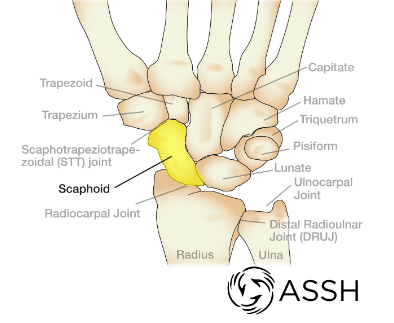Scapholunate Torn Ligament
A very common ligament injured during a wrist sprain is the scapholunate ligament. This ligament is in the middle of the wrist between the scaphoid and lunate bones (Figure 1). It is an important structure in the middle of the wrist and is critical for painless and full wrist motion. When it is injured, the scapholunate ligament can be just stretched, causing instability, or you may be suffering from a completely torn ligament.

Causes
Falls on the hand, or similar forceful injures, are the typical cause of a torn ligament. Typically, the scapholunate ligament is injured when the wrist is bent backwards or into an unusual position. Sometimes the ligament stretches out over time, possibly due to repeated strains or with age. Inflammatory arthritis like rheumatoid arthritis can also lead to a gradual deterioration of the ligament.
Signs and Symptoms
A wrist with a torn scapholunate ligament is often swollen and painful, especially with certain motions. You may also see the following symptoms:
- Pain when bending the wrist backward
- Limited range of motion
- Bruising
- Pain and swelling that has developed over several days, usually on the backside of the wrist
- Popping or grinding sensation
- Weakness in the wrist
The pain and swelling you feel with a torn ligament may persist and become worse. However, some people will only notice a problem many years after the initial injury.
Diagnosis

A diagnosis of scapholunate instability may be difficult to make. Your doctor will examine your wrist to see where it hurts and to check how it moves. X-rays are often used to help understand your wrist pain. Your surgeon may compare the injured wrist with the uninjured wrist. When the ligament is torn, it no longer holds two carpal bones (the scaphoid and the lunate) together, allowing a gap to form between them (Figure 2), and the bones move separately from one another. MRI can also aid in diagnosis of these injuries. If left untreated, ligament tears typically lead to arthritis over time.
Treatment
When the scapholunate ligament is torn, surgery may offer some improvement in pain or swelling. Your hand surgeon will discuss your options ranging from steroid injections to arthroscopic surgery or repair and reconstruction. There are other options available when the injury has become more chronic. Occasionally cutting the nerves to the inside of the wrist (wrist denervation) can help with pain. These procedures may serve to improve pain and function. Wrist stiffness is a common side effect of ligament reconstruction, but frequently the wrist already has a limited range of motion due to the original injury.
Prognosis
Scapholunate ligament tears do not heal on their own. They frequently become painful, sometimes many years after the original injury. Because the torn ligament no longer moves the carpal bones correctly, arthritis is often a long-term effect. Your surgeon may be able to offer you further treatment options so your wrist can function better even years after a scapholunate ligament tear.
